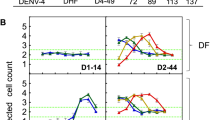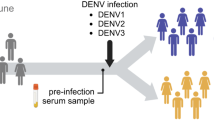Abstract
Two monkeys (Macaca fascicularis) each were infected with dengue virus type 1 (DENV-1) and type 2 (DENV-2). High levels of neutralizing antibody to homotypic serotype were detected from day 10 to week 58 after infection. Levels of cross-reactive neutralizing antibody to other serotypes were at lower levels or undetectable. Serum samples collected from day 10 to week 58 enhanced infection by homotypic and heterotypic serotypes of DENV when diluted, demonstrating antibody-dependent enhancement (ADE). The ADE activities to heterotypic and homotypic dengue virus infections peaked at dilutions of 1:10–1:100 and 1:100–1:1,000, respectively. Serum samples collected enhanced heterotypic dengue virus infection without any dilution. The results indicate that sera from infected monkeys have an ability to enhance heterotypic dengue virus infection in vitro without dilution, although some of these sera also possess neutralizing activity.



Similar content being viewed by others
References
Halstead SB (1988) Pathogenesis of dengue: challenges to molecular biology. Science 239:476–481
Kliks SC, Nimmanitya S, Nisalak A, Burke DS (1988) Evidence that maternal dengue antibodies are important in the development of dengue hemorrhagic fever in infants. Am J Trop Med Hyg 38:411–419
Guzman MG, Kouri GP, Bravo J, Soler M, Vazquez S, Morier L (1990) Dengue hemorrhagic fever in Cuba, 1981: a retrospective seroepidemiologic study. Am J Trop Med Hyg 42:179–184
Kliks SC, Nisalak A, Brandt WE, Wahl L, Burke DS (1989) Antibody-dependent enhancement of dengue virus growth in human monocytes as a risk factor for dengue hemorrhagic fever. Am J Trop Med Hyg 40:444–451
Johnson AJ, Roehrig JT (1999) New mouse model for dengue virus vaccine testing. J Virol 73:783–786
Halstead SB, Shotwell H, Casals J (1973) Studies on the pathogenesis of dengue infection in monkeys. I. Clinical laboratory responses to heterologous infection. J Infect Dis 128:7–14
Halstead SB, Shotwell H, Casals J (1973) Studies on the pathogenesis of dengue infection in monkeys. II. Clinical laboratory responses to heterologous infection. J Infect Dis 128:15–22
Schiavetta AM, Harre JG, Wagner E, Simmons M, Raviprakash K (2003) Variable susceptibility of the owl monkey (Aotus nancymae) to four serotypes of dengue virus. Contemp Top Lab Anim Sci 42:12–20
Ito M, Takasaki T, Yamada K, Nerome R, Tajima S, Kurane I (2004) Development and evaluation of fluorogenic TaqMan reverse transcriptase PCR assays for detection of dengue virus types 1 to 4. J Clin Microbiol 42:5935–5937
Yamada K, Takasaki T, Nawa M, Kurane I (2002) Virus isolation as one of the diagnostic methods for dengue virus infection. J Clin Virol 24:203–209
Kelly EP, Greene JJ, King AD, Innis BL (2000) Purified dengue 2 virus envelope glycoprotein aggregates produced by baculovirus are immunogenic in mice. Vaccine 18:2549–2559
Reed LJ, Muench HA (1938) Simple method of estimating fifty percent endpoints. Am J Hyg 27:493–497
Kontny U, Kurane I, Ennis FA (1988) Gamma interferon augments Fc gamma receptor-mediated dengue virus infection of human monocytic cells. J Virol 62:3928–3933
Halstead SB, Heinz FX, Barrett AD, Roehrig JT (2005) Dengue virus: molecular basis of cell entry and pathogenesis. Vaccine 23:849–856
Acknowledgments
Animal procedures were approved by the Committees on Biosafety and Animal Handling and Ethical Regulations of the National Institute of Infectious, Diseases, Japan. This work was supported by the Research on Emerging and Re-emerging Infectious Diseases from Ministry of Health, Labour and Welfare, Japan (H17-Shinkou-019 and H20-Shinkou-ippan-015), and the Research on Biological Resources and Animal Models for Drug Development from Ministry of Health, Labour and Welfare, Japan (H19-Seibutsushigen-ippan-003).
Author information
Authors and Affiliations
Corresponding author
Rights and permissions
About this article
Cite this article
Ito, M., Mukai, Rz., Takasaki, T. et al. Antibody-dependent enhancement of dengue virus infection in vitro by undiluted sera from monkeys infected with heterotypic dengue virus. Arch Virol 155, 1617–1624 (2010). https://doi.org/10.1007/s00705-010-0741-x
Received:
Accepted:
Published:
Issue Date:
DOI: https://doi.org/10.1007/s00705-010-0741-x




